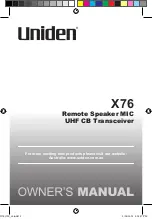
2-2
Maintenance
dislodged material out and away from the inside of the radio. Make sure that controls or tunable
components are not soaked with alcohol. Do not use high-pressure air to hasten the drying process
since this could cause the liquid to collect in unwanted places. After completing the cleaning process,
use a soft, absorbent, lintless cloth to dry the area. Do not brush or apply any Isopropyl alcohol to the
frame, front cover, or back cover.
2.3
Safe Handling of CMOS and LDMOS Devices
Complementary metal-oxide semiconductor (CMOS) devices are used in this family of radios, and are
susceptible to damage by electrostatic or high voltage charges. Damage can be latent, resulting in
failures occurring weeks or months later. Therefore, special precautions must be taken to prevent
device damage during disassembly, troubleshooting, and repair.
Handling precautions are mandatory for CMOS circuits and are especially important in low humidity
conditions. DO NOT attempt to disassemble the radio without first referring to the above CAUTION
statement.
2.4
Repair Procedures and Techniques — General
Parts Replacement and Substitution
When damaged parts are replaced, identical parts should be used. If the identical replacement part is
not locally available, check the parts list for the proper Motorola part number. Order parts from the
nearest Motorola Communications parts center listed in Chapter 1, Introduction.
Note: Always use a fresh supply of alcohol and a clean container to prevent contamination
by dissolved material (from previous usage).
CAUTION: This radio contains static-sensitive devices. Do not open the radio unless
you are properly grounded. Take the following precautions when working
on this unit:
l
Store and transport all CMOS devices in conductive material so that all exposed
leads are shorted together. Do not insert CMOS devices into conventional plastic
“snow” trays used for storage and transportation of other semiconductor devices.
l
Ground the working surface of the service bench to protect the CMOS device. We
recommend using the Motorola Static Protection Assembly (part number
0180386A82), which includes a wrist strap, two ground cords, a table mat, and a
floor mat.
l
Wear a conductive wrist strap in series with a 100k resistor to ground. (Replace-
ment wrist straps that connect to the bench top covering are Motorola part number
RSX-4015.)
l
Do not wear nylon clothing while handling CMOS devices.
l
Do not insert or remove CMOS devices with power applied. Check all power sup-
plies used for testing CMOS devices to be certain that there are no voltage tran-
sients present.
l
When straightening CMOS pins, provide ground straps for the apparatus used.
l
When soldering, use a grounded soldering iron.
l
If at all possible, handle CMOS devices by the package and not by the leads. Prior
to touching the unit, touch an electrical ground to remove any static charge that
you may have accumulated. The package and substrate may be electrically com-
mon. If so, the reaction of a discharge to the case would cause the same damage
as touching the leads.
!
C a u t i o n
Summary of Contents for CDM1250
Page 1: ...CDM Series Professional Series Two Way Mobile Radio Basic Service Manual ...
Page 2: ......
Page 30: ... ...
Page 34: ...2 22 Service Aids Notes ...
Page 60: ...4 18 Radio Programming and Tuning Procedures Notes ...
Page 72: ...6 8 Accessories Notes ...
Page 86: ...7 14 Model Chart and Test Specifications NOTES ...
Page 90: ...Glossary 4 Glossary Notes ...
Page 91: ......














































